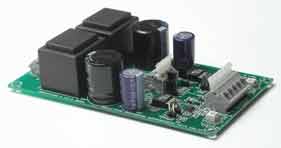Build directions
Click on the picture to see a preview of the pcb.
This design is very easy to build. You can of course solder everything and then apply voltage but maybe it doesn't hurt to be a little cautious. You should start with all low SMD parts except for the buffer and the opamp becuase it's harder to solder the SMD parts when you have big parts in the way. For this solder job I recommend a good pair of tweezers. I use a type especially made for SMD. With this tweezer I'll get a very good grip. You must also have a soldering iron with a small tip but at least 50 watts in order to be able to solder the buffer which requires lot's of heat.
Start with all low SMD parts except for buffer and opamp
- Resistors
Transistors
Trim pot (if you use it)
Capacitors, not the hole mounted ones
Rectifier bridges, at last - Then continue with the high electrolytic caps, mount all caps
- Connectors
- Jumpers
- Transformers
- Varistor
Check the power supply
Apply voltage, 230 volts AC. Check that the regulators give the expected voltage, +- 15 volts except when you plan to use AD8610. Disconnect the power and see to that the voltage is zero when you continue the soldering.
Continue with the opamp and buffer
- Opamp.
- Buffer. This parts needs to be soldered into the large pad on the pcb. To do this you must use lot's of heat. If you have two soldering irons, use both at the same time. The buffer gets it's cooling via this pad so it's important that the buffer is very good soldered.
Check the finished amp
Apply voltage again and check the output voltage. Measure the DC voltage at the output. It should be the specified offset voltage (see datasheet) and times the gain, 4 in this case. I got 78 uV(!) for AD8610, 2.56 mV for OPA134 and 0.7 mV for OPA627
Check voltage regulation
Connect the amp for high speed mode. The pcb and the transformers get hot (or at least warm) eventually. Check that the supply voltage still is +-15 volts or the value you have chosen.
The whole amp is ready.
Test if you want the different drive and speed modes. It is safe to change modes when voltage and input signal is applied. You won't even hear a click.
Good luck and happy listening.

